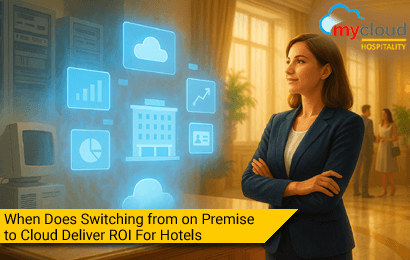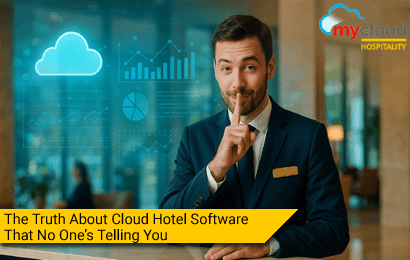Dynamic pricing has long been a staple in hospitality. Adjust your rates, follow the market, and win bookings—right? Not quite. In 2025, that approach alone won’t cut it. With demand patterns shifting hourly, guests comparing 10+ tabs before booking, and real-time events turning local markets upside down, pricing has become a high-stakes game of strategy, not guesswork.
Today’s hotel pricing decisions are more complex than ever. They’re influenced by everything from competitor rates and last-minute group bookings to online reviews and even weather patterns. For revenue managers, reacting fast enough is nearly impossible—unless you’re supported by intelligence that never sleeps.
Enter AI-based revenue management systems. These tools don’t just automate pricing; they transform how hoteliers think about rate strategies—by blending machine learning, real-time data, and predictive algorithms into a powerful decision-making engine.
In this blog, we’ll uncover how AI has reshaped hospitality revenue management, why traditional approaches fall short, and how forward-thinking properties—from independent hotels to global resorts—are turning data into profit with platforms like mycloud PMS. Let’s explore.
The Broader Challenge of Revenue Management Today
Modern hospitality revenue management is no longer a linear task. Fluctuating demand, multi-channel distribution, labor constraints, and guest expectations have upended old pricing models. According to Skift, 60% of hoteliers cite demand unpredictability as their top pricing challenge in 2024.
Traditional revenue management systems often rely on static rules—such as setting rates based on season or day of the week. But these approaches fail to account for real-time shifts like a sudden flight cancellation or an influencer event in town. Manual rate updates across OTAs and direct booking engines can take hours—hours that cost you bookings and revenue.
The consequences are stark: reactive pricing means missed upselling opportunities, rooms left unsold, and an over-reliance on discounting just to keep occupancy afloat. When labor shortages limit the ability to monitor rate performance daily, your margins shrink even faster.
To thrive in this climate, hotels need systems that see patterns faster than a human ever could—and respond automatically. Let’s explore how AI delivers on that promise.
What is AI-Based Hotel Revenue Management?
AI-based revenue management is the evolution of smart pricing for hotels. Rather than depending on past trends and human intuition, AI tools use machine learning to analyze vast datasets in real time. These systems optimize not just pricing, but inventory distribution, segmentation, and demand forecasting.
Here’s how it works: the AI ingests real-time inputs like booking pace, competitor rates, weather forecasts, social sentiment, and even local search activity for hotels and flights. It then suggests—or directly implements—pricing adjustments tailored to maximize occupancy and RevPAR.
Unlike traditional dynamic pricing, which changes rates based on simple supply-demand rules, AI-based RM is decision intelligence. It identifies subtle patterns—like a growing interest from family travelers or rising flight searches from a specific origin—and responds before your competitors even notice.
A McKinsey report found that companies leveraging AI in revenue decisions saw 5–15% revenue improvement within months. That’s not just automation; it’s precision. Let’s explore how that translates into real benefits.
Benefits of AI-Based Hotel Revenue Management
1. Real-Time Pricing and Inventory Optimization
AI enables hotels to adjust prices not just daily, but in real time—responding to competitor rates, local events, and booking pace instantly. This isn’t just faster—it’s smarter.
Take the example of a business hotel near Mumbai’s BKC (Bandra-Kurla Complex) that used AI-powered rate adjustments during a major banking conference. As room demand surged, the system increased rates for executive rooms by 22% within an hour—far ahead of the manual response of nearby competitors—leading to full occupancy and a 17% boost in ADR over the previous year.
Additionally, the AI engine optimized room-type yields by offering better prices for suites to high-spending corporate travelers, while keeping base rooms affordable to attract volume.
2. Advanced Forecasting & Scenario Planning
Predictive models powered by AI help hotels anticipate demand spikes due to festivals, holidays, or events, and make proactive pricing decisions instead of reactive ones.
For instance, a resort in Udaipur used AI forecasting to prepare for the surge in wedding inquiries from October to February. The tool predicted pick-up trends based on online search data, enquiry volume, and historical lead times. As a result, the property launched early-bird packages in August—securing over 40% of its winter wedding inventory months in advance.
3. Segmentation & Channel Profitability
AI allows hotels to tailor rates by segment—business, leisure, FITs, or OTAs—and optimize profitability by focusing on high-value channels.
A mid-sized hotel chain operating in South India analyzed channel mix data using AI. It discovered that direct bookings had a higher conversion rate during weekdays from returning corporate travelers. The system responded by offering better loyalty discounts on direct channels while pushing OTA promotions only on weekends—reducing OTA dependency by 26% in one quarter.
4. Efficiency for Revenue Managers
AI takes over routine tasks like rate monitoring and data crunching, so revenue managers can focus on strategy, group pricing, and campaign design.
At a luxury hotel in Delhi Aerocity, the revenue team reduced manual rate updates by 80% after adopting an AI-based RMS integrated with their Hospitality Management System. This allowed them to concentrate on launching profitable weekend escape packages and partnering with airline loyalty programs—boosting weekend occupancy by 19%.
Let’s explore how this all plays out in real-world scenarios.
Real-Life Applications
Example 1: Independent Hotel in Jaipur Boosts RevPAR by 20%
An independent 50-room heritage hotel in Jaipur integrated an AI-based revenue management module with its existing Hospitality Management System. With unpredictable seasonal footfall and a wide mix of domestic and international travelers, the hotel often struggled with flat-rate pricing and last-minute discounting.
After implementing AI-driven rate intelligence, the hotel began tracking real-time booking behavior, search trends for Jaipur, and competitor pricing on major OTAs. During the Jaipur Literature Festival, the system dynamically increased room rates by up to 25% based on demand surges—without human intervention—leading to a 20% YoY increase in RevPAR and nearly full occupancy during the entire event week.
Example 2: Goa Resort Maximizes Holiday and Cancellation Revenue
A beachfront resort in North Goa faced challenges balancing demand across long weekends, last-minute group inquiries, and frequent cancellations. By deploying AI tools integrated with mycloud PMS, the property began dynamically adjusting rates based on demand spikes from metro cities and forecasted cancellations from past booking behavior.
When a major music festival was announced just 10 days prior to New Year’s Eve, the system responded by immediately increasing rates and adjusting minimum stay requirements. The result? 18% uplift in ADR and a sharp 30% reduction in last-minute revenue leakage from cancellations and rebookings.
Key Features of an AI-Based Revenue Management System
To deliver these results, your system needs to go beyond the basics. Here’s what to look for:
- Real-Time Data Integration: Pulls live booking, weather, events, and search data.
- Competitive Rate Intelligence: Continuously benchmarks against market leaders.
- Forecasting Engine: Predicts demand, revenue, and occupancy with high accuracy.
- Custom Override Rules: Allows manual control when needed—especially for group bookings or special campaigns.
- Channel Integration: Syncs rates across OTAs, GDS, and direct platforms automatically.
- Dashboard Support: Visualizes pricing suggestions, pacing, and revenue metrics clearly.
Let’s now figure out if your hotel is ready for this shift.
Is AI-Based RM Right for Your Hotel?
Here’s a quick self-check:
- Do your occupancy levels swing week to week?
- Is your pricing based on rules rather than real-time behavior?
- Does your team spend hours adjusting rates across channels?
- Are you struggling to respond quickly to cancellations or demand spikes?
If you said yes to any, then AI-driven revenue management isn’t just “nice to have”—it’s essential.
And no, it’s not just for mega chains. According to Revinate, 52% of independent properties now use some form of AI or decision automation for pricing. With platforms like mycloud PMS, even smaller hotels can access advanced tools once reserved for corporate brands.
Let’s see how mycloud makes this possible.
How mycloud PMS Enables AI-Based Hotel Revenue Management
mycloud Hospitality Management System offers an all-in-one platform where AI meets real-time decision support.
- Built-In Revenue Optimization: Embedded logic adjusts rates based on occupancy, pacing, and demand signals.
- Integrated Rate Intelligence: Tracks competitor rates and local events continuously.
- Custom Pricing Logic: Allows rules for campaigns, early bird offers, or last-minute deals.
- OTA & Channel Sync: One click updates across Booking.com, Expedia, and direct channels.
- Forecast Dashboards: Visual tools help you see expected pick-up and make timely adjustments.
- Designed for Mid-Market & Independents: No massive IT team needed—just intuitive dashboards and onboarding support.
Case in point: A 60-room business hotel in Mumbai using mycloud PMS integrated with an AI-based RMS reported a 14% RevPAR boost in under six months, along with a 30% drop in OTA dependency.
Now that you’re convinced of the benefits, how do you begin?
How to Get Started
Here’s your launchpad to smarter revenue:
1. Assess Readiness
- Do you have a digital PMS and centralized data access?
- Is your team open to automation and learning new tools?
2. Align Your Team
- Provide training for revenue, front office, and reservations teams.
- Define override and escalation protocols.
3. Implement in Phases
- Start with one segment or rate category.
- Use dashboards to review decisions and tweak settings.
4. Suggested Tools
- Combine your hospitality management system with AI-based pricing like those integrated in mycloud PMS.
- Ensure full OTA sync and historical data import.
Let’s wrap it up.
Conclusion
AI-based revenue management isn’t just a trend—it’s the future of smart pricing for hotels. From predictive forecasting and market-aware pricing to optimized channel strategies and team efficiency, AI gives hoteliers the edge they need in an ultra-competitive market.
Remember: in today’s rate wars, winners don’t guess—they know. They predict. They adapt instantly.
If you’re ready to elevate your revenue game, it’s time to explore how AI-powered tools in mycloud PMS can reshape your strategy.
Schedule a demo or get a 30-day free trial of mycloud Hospitality Management System today—and start making every rate count.










